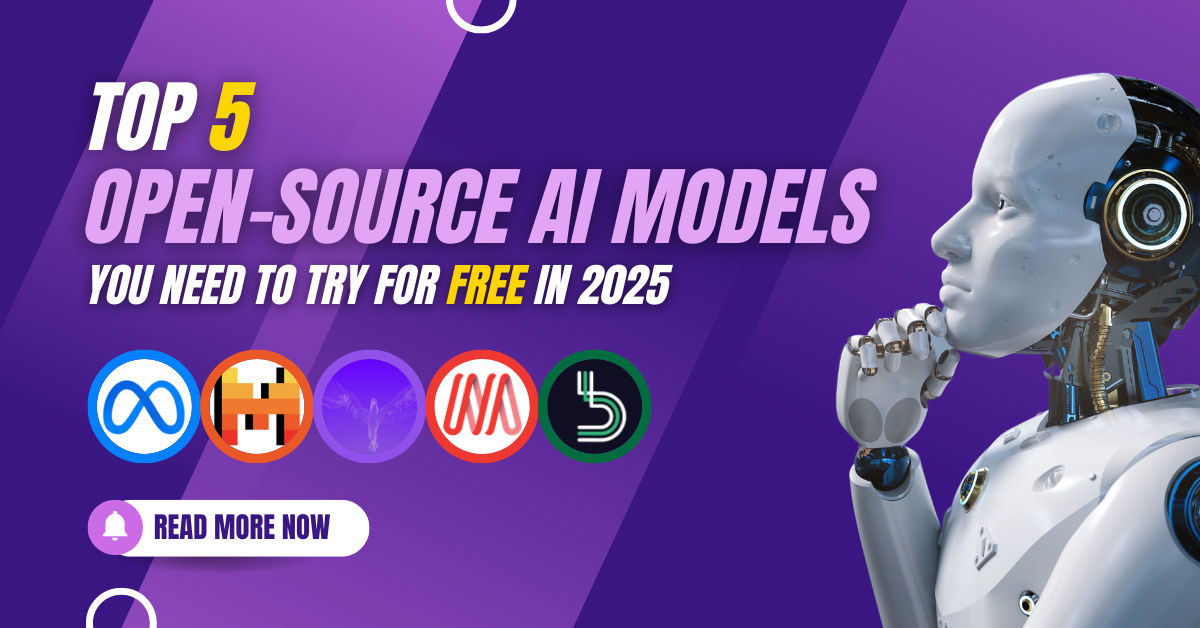AI is evolving fast, and open-source LLMs are leading the charge! From Meta’s LLaMA 2 to Falcon 180B, these models offer powerful text generation, coding, and research capabilities—without the hefty price tag of proprietary AI. But which model fits your needs best? Whether you're a startup, researcher, or enterprise, we break it all down. Don't miss out—find your perfect AI assistant today!

Imagine having an assistant who can write, brainstorm, translate, and even code for you. That’s the magic of large language models (LLMs). These powerful AI models are trained to understand and generate human-like text, making them useful for everything from chatbots to research papers.
Open-source LLMs have changed the game by making AI more accessible. Unlike proprietary models like GPT-4, Gemini, or Claude, which are expensive and closed off, open-source LLMs allow anyone to use, modify, and improve them. They offer flexibility, cost savings, and a strong community of developers pushing the boundaries of AI innovation.
But how do you choose the right LLM? The answer depends on what you need it for—whether it’s research, business, chatbots, coding, healthcare, or finance. In this guide, we’ll break down the top five open-source LLMs and help you decide which one fits your needs best.
Before diving into the models, let’s set the stage with the key factors we’ll use to compare them:
Performance – How well does the model generate accurate and coherent responses?
Size & Scalability – How big is the model, and how easy is it to fine-tune?
License Type – Can you use it freely for commercial purposes?
Ease of Use – How simple is it to integrate and run on available hardware?
Training Data & Bias – What data was used to train the model, and are there biases?
Inference Cost & Power Efficiency – How much computing power does it need?
Community & Ecosystem Support – Is there an active developer community and regular updates?
Best Use Cases – What applications is the model best suited for?
Now, let’s explore the top contenders!
LLaMA 2 is Meta’s latest open-source LLM, designed for research and commercial use. It is available in different sizes (7B, 13B, and 65B parameters) to suit various needs.
Strong natural language understanding.
Available in multiple sizes for flexibility.
Optimized for efficiency with lower hardware requirements.
High accuracy in text generation.
Open-weight access for customization.
Active community support.
Larger models need specialized hardware.
Some restrictions on commercial use.
Best For: AI researchers, chatbot development, academic applications.
Mistral 7B is a lightweight yet powerful model, built for strong reasoning capabilities with a small footprint.
Only 7B parameters but outperforms some larger models.
Fully open-source under the Apache 2.0 license.
Optimized for efficiency and commercial applications.
High efficiency with low hardware demands.
Flexible licensing for businesses.
Ideal for resource-limited environments.
Smaller training datasets than larger models.
Needs external fine-tuning for some tasks.
Best For: Startups, AI apps, edge AI applications.
Developed by the Technology Innovation Institute (TII), Falcon 180B is one of the largest open-source LLMs, rivaling proprietary models.
Massive 180B parameters.
High performance in reasoning and coding.
Supports multiple languages.
Matches the performance of some paid models.
Open access for both research and commercial use.
Excels in long-context understanding.
Requires substantial computing power.
Expensive to train and deploy.
Best For: Enterprises, large-scale AI research, automation projects.
MPT-30B is a scalable model optimized for efficiency and adaptability with no commercial restrictions.
Available in multiple instruction-tuned versions.
Efficient memory usage.
Easy to fine-tune.
Great for inference efficiency.
Easier to fine-tune than some competitors.
Strong all-round performance.
Mid-range capabilities compared to bigger models.
Limited multilingual support.
Best For: AI startups, real-time applications, and educational projects.
BLOOM is a community-driven model with exceptional multilingual capabilities.
176B parameters, trained on diverse datasets.
Supports multiple languages fluently.
Developed with full transparency.
Best-in-class multilingual processing.
Fully open and transparent development.
Great for research applications.
Requires high-end hardware.
Slightly slower than Falcon 180B for some tasks.
Best For: Language research, cross-cultural AI, academic projects.
|
Model |
Parameters |
License |
Performance |
Best Use Cases |
|
LLaMA 2 |
7B, 13B, 65B |
Custom (Meta) |
High |
Research, Chatbots |
|
Mistral 7B |
7B |
Apache 2.0 |
High for size |
Lightweight AI, Startups |
|
Falcon 180B |
180B |
Apache 2.0 |
Very High |
Large-scale AI, Enterprises |
|
MPT-30B |
30B |
Apache 2.0 |
Medium-High |
Real-time AI, Education |
|
BLOOM |
176B |
RAIL License |
High |
Multilingual AI, Research |
If you need an efficient, lightweight model: Mistral 7B
If you want a balance between performance and usability, LLaMA 2 (13B or 65B)
For enterprise-level AI: Falcon 180B
If multilingual support is essential: BLOOM
If you need an adaptable, instruction-tuned model, MPT-30B
Open-source LLMs are evolving fast, with new models regularly emerging. Look for upcoming releases from Meta, Hugging Face, and other research groups. Improvements in fine-tuning and efficiency will continue to shape the AI landscape.
The best open-source LLM depends on your needs. Mistral 7B is excellent for lightweight applications, LLaMA 2 offers versatility, BLOOM excels in multilingual tasks, and Falcon 180B is perfect for enterprise use. Choose wisely and let AI power your next big idea!
Sign up to gain AI-driven insights and tools that set you apart from the crowd. Become the leader you’re meant to be.
Start My AI Journey
ThatsMyAI
20 March 2025

ThatsMyAI
7 March 2025